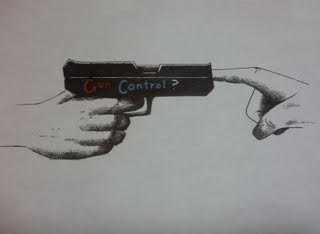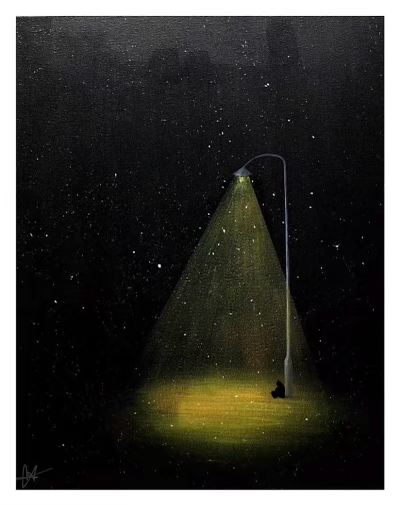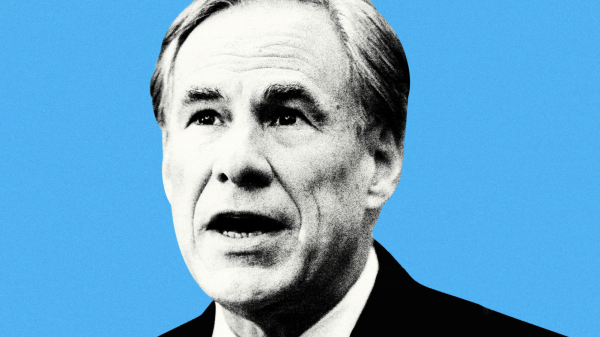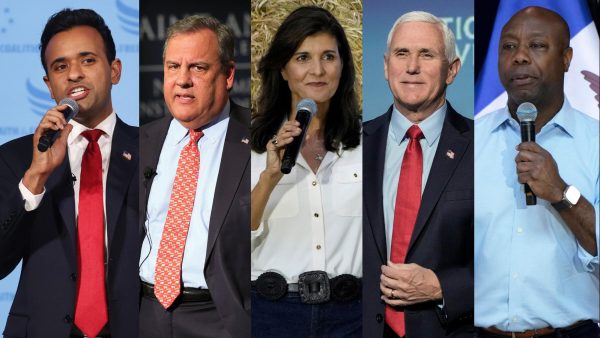END THE GUN CRISIS IN AMERICA

Art credits to Brian Wen!
February 22, 2016
The fundamental right to live: It was robbed from the families of twenty first graders in Newtown. It was taken from college kids in Oregon and high schoolers in Columbine. It was seized from charity workers in San Bernardino and from dedicated marines in Chattanooga. It was defiled in a church in Charleston and in a movie theater in Aurora.
In this country, the reality is that this inherent human right to live is being assaulted and trodden upon every few weeks. No matter how many times some try to twist, distort, and reject the necessary conversation on guns, the truth is we have a gaping gun problem in this country.
According to a Harvard Study, mass shootings took place within 64 days of each other in the span of time between 2011 and 2015. From 1983 to 2011, however, mass shootings used to take place within 200 days of each other, indicating that the frequency of these shooting has tripled in just the last few years. Some attribute this trend to an increase in terrorism, while others blame a mental health epidemic. One side blames the lack of gun control measures, yet the other side insists that these shootings occur because of strict gun control laws. What gun control laws?
The problem is that there are no laws. As long as certain stubborn politicians—as well as the invisible, hideous gun lobby that controls them—continue to wage war against common sense, then mass shootings shall simply become the status quo.
The cyclical and predictable responses after these horrific shootings certainly do suggest that Americans have just accepted that “stuff happens.” Everyone always reacts with horror, disgust, fright, and sympathy. But when the dust settles and the condemnations die down, the people who really have the power to drive real change turn their backs. After the Newtown shootings, the National Rifle Association (NRA) president, Wayne LaPierre, advocated against both an assault weapons ban and expanded background checks—and instead fought to arm teachers.
To arm teachers. Not only is this nowhere near the best option and would waste unnecessary resources, but it would also exacerbate the problem. As Jennifer Huang ’18 affirms, “Studies by the University of Pennsylvania have proven that if a person, say a teacher, has a gun and tries to confront the shooter, the chance that anyone gets shot increased 4.5 times.” So it seems that whatever alternate reality the NRA tries to sell the American people, the truth is that there can be no skirting around the issue by proposing a silly “arm the teachers” proposal.
So then what should we do to maintain public safety if not to arm teachers? The first step would require lawmakers and the American people to reconcile the second amendment with common sense gun control measures. Such measures would then include assault weapons bans, expanded background checks, tighter regulation on gun sales, stricter fines for violations, more Bureau of Alcohol, Transportation, and Firearms (ATF) monitors, and accommodations for the mentally ill.
But, for the promise of reform to take place, we must find ways to ensure the enforcement of the second amendment so that it complies with basic rationality. Understanding the context of the amendment is quite easy. Clearly, it allows for citizens to bear arms. But the level of the interpretation of that declaration can be quite destructive. The founding fathers wrote that amendment 250 years ago after a war of independence against a restrictive, controlling, and oppressive mother country—thus, the right of ordinary citizens to take up arms exists. Though this may be difficult for some to believe, the government today is not declaring martial law in Boston over tea, controlling where our companies trade, or denying us representation. So maybe – just maybe – in times of peace, we can limit our guns to something less than armor piercing rounds.
And that leads up to the second troubling aspect of the second amendment: its time period. When the founding fathers envisioned the right to bear arms, Max Sun ’18 comments, “They imagined people carrying slow, inaccurate muskets, not lunatics with rapid fire assault weapons. The Constitution is a living document and should be interpreted according to ever-changing times.” So as Max Sun iterates, by balancing what this contentious amendment allows for, understanding its context, and realizing what common sense dictates, we can navigate a middle ground.
Lawmakers, in 1994, achieved this middle ground when they passed a bipartisan assault weapons ban. This banned the manufacturing of all assault weapons and limited the number of bullets in each magazine to ten. Ever since it expired in 2004 due to gun lobby influences, the amount of mass shootings has doubled. If this ban had been in place, Adam Lanza would not have had the ability to use an M4 carbine rifle against first graders. Syed Farooq and Tashfeen Malik would not have so easily killed 14 of their colleagues in San Bernardino.
But an assault weapons ban simply is not enough to prevent mass shootings. Adam Lanza with an assault weapon still possesses the same madness, insanity, and murderousness as an Adam Lanza with a pistol. That is why President Obama has made it one of his objectives to introduce a series of gun control executive actions to try to regulate who sells guns and who gets guns, and examine if that person has some sort of criminal or mental health history:
- First, Obama would try to research the mental health epidemic in this country in an attempt to find new ways to curb it and better accommodate those who are mentally ill. This is actually one of the few areas of the gun debate that has widespread support. According to an October Washington Post poll, 63% of Americans say addressing the mental health epidemic would contribute the most to solving the mass shooting crisis.
- Along with funding the private sector to research mental health issues, Obama’s measures also include expanding background checks—a measure, according to NPR, that 90% of Americans and 75% of NRA members support. These background checks could ensure that someone who has a violent criminal history, or someone who has a mental illness (i.e. schizophrenia), cannot buy a gun.
- Further, he would expand the number of ATF agents by 200 in an attempt to clamp down on illegal gun sales—that is, people who sell guns without the necessary paperwork and credentials to those without gun licenses.
The key critics of Obama’s proposals, however, declare that they are unconstitutional and tyrannical. “This [view] is silly,” Anina Ku ’18 responds. “Promoting mental health and increasing the number of ATF monitors is certainly not unconstitutional.” To reiterate, the “unconstitutional” excuse, as Anina points out, simply holds no water in defending against reform. It means Obama’s actions, or at least some parts of them, can pass as laws without even interfering with the second amendment.
The real frustration is that while the majority of Americans earnestly support these measures, certain politicians, who supposedly represent the people have failed to enact any legislation. President Obama’s maneuver to bypass a gridlocked and lobby-controlled Congress should come as no surprise. But having a multitude of politicians who are not afraid to enact positive change and who can stand up to the gun lobby’s lies will produce an atmosphere that can achieve more powerful and un-polarized results.
This nation can fix this, but it would require unrelenting focus, sincere dedication, and a reform-driven mindset. Only until this happens can we look our children in the eye and tell them that we tried to make them safe.





Samena Hossain • Feb 29, 2016 at 12:42 pm
I think this is defintiley very important to think about, because the use of guns havent been taken seriously lately and it should because it is a big problem everywhere and is the main reason why everyone is going crazy.
michael • Feb 29, 2016 at 12:01 pm
that is a nice topic i agreee with the author. the use of examples made the statement.